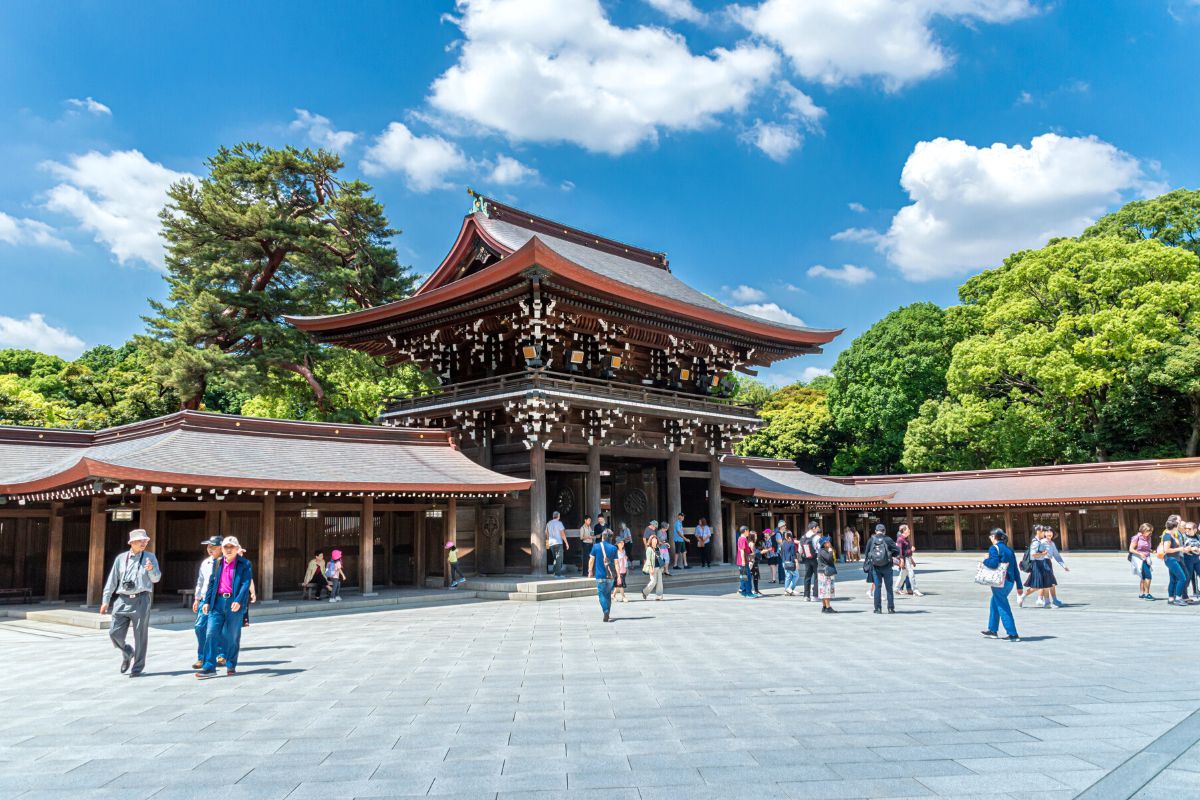Meiji Shrine: Tickets and Tours
Escape the bustling streets of Tokyo and make your way to the Meiji Shrine, a sanctuary that stands as a testament to Japan's rich history and enduring traditions.
Visiting this revered Shinto shrine is a journey into the very soul of Japan, where past and present converge in harmony. Here you will learn about the beautiful customs of the religion and you will take a moment to reflect, breathe and recharge.
Escape the bustling streets of Tokyo and make your way to the Meiji Shrine, a sanctuary that stands as a testament to Japan's rich history and enduring traditions.
Visiting this revered Shinto shrine is a journey into the very soul of Japan, where past and present converge in harmony. Here you will learn about the beautiful customs of the religion and you will take a moment to reflect, breathe and recharge.

(0/24) checking Musement...
Escape the bustling streets of Tokyo and make your way to the Meiji Shrine, a sanctuary that stands as a testament to Japan's rich history and enduring traditions.
Visiting this revered Shinto shrine is a journey into the very soul of Japan, where past and present converge in harmony. Here you will learn about the beautiful customs of the religion and you will take a moment to reflect, breathe and recharge.

Here's all you need to know about visiting the Meiji Shrine, one of the most sacred attractions in Tokyo.
How much do Meiji Shrine tickets cost?
There is no entry fee for Meiji Shrine but the inner garden (Meiji Jingu Gyoen) requires a small fee.
It is advised that you book a tour to fully appreciate the magnitude of the shrine and Shinto Culture. For US$50 per person, you can join a group tour through the facility, ending with a personal prayer.
Your guide will introduce you to the many aspects of Shinto traditions and help you embrace the beautiful customs observed at the shrine.
Why should I book in advance?
Most Meiji Shrine tours are limited to only a small number of people or are private. This means it is essential to book in advance to secure a spot, as these experiences are likely to sell out.
What are the most popular Meiji Shrine tours?
Personal prayer at Meiji Shrine
Join a Meiji Shrine tour that has curated the deep and meaningful practices of Shinto into one immersive experience. The tour aims to guide you through the profound philosophy and rituals of Shinto, offering you the chance to connect with its essence on a personal level.
During your private prayer session, you'll have the opportunity to express your heartfelt wishes. As you step into a tranquil tatami room, you'll witness the ancient traditions of purification, with priests adorned in centuries-old garb, the resonant sound of bells, and the mesmerizing performance of Gagaku. A Miko, or shrine maiden, will also grace you with a traditional dance performance.
Finally, you'll receive an Ofuda – a sacred amulet infused with your wishes and the spiritual power of your prayer.
Are there any combined tickets or tours including the Meiji Shrine and other attractions?

Combo tours are the best way to see multiple top attractions in Tokyo, weaving together the story of how the city developed with culturally significant locations.
- Meiji Shrine and other Tokyo Highlights: Enjoy the tranquility of the Meiji Shrine but also visit Asakusa, Ueno and the Tokyo National Museum.
- Meiji Shrine and Senso-ji and Harajuku: This walking tour takes you through the past and into the brightly lit future of Tokyo as part of a 3-hour small-group experience.
What will you see inside?

At the Meiji Shrine in Tokyo, visitors are greeted by an oasis of tranquility nestled amidst the bustling cityscape as you walk down a majestic path lined with towering cryptomeria trees, some as old as the shrine itself.
This enchanting avenue is known as the "Sando" or sacred path, leading visitors towards the shrine's main precincts. As you approach the main shrine buildings, you'll notice the shrine's iconic thatched roofs and the striking contrast of their dark wood against the brilliant white walls.
Within the shrine grounds, you'll find a large courtyard with a serene pond, home to koi fish and vibrant water lilies. Here, visitors can partake in rituals like the cleansing of hands and mouth before approaching the main hall.
Emperor Meiji and Empress Shoken are enshrined here, and you'll find their venerated images along with offerings of sake and seasonal fruits. It's a place for both tourists and locals to pay their respects, offer prayers, and experience the spiritual side of Japanese culture amidst the beauty of nature.
Where is the Meiji Shrine located?
To reach Meiji Shrine, simply take a short walk from either Harajuku Station on the JR Yamanote Line or Meiji-Jingu-mae Station on the Chiyoda and Fukutoshin subway lines.
What are the opening times?
The Meiji Shrine's opening times change every month and are linked to sunrise and sunset. Some facilities inside the complex are only open from 9 AM to 4 PM.
- January: 6:40 AM - 4:20 PM
- February: 6:20 AM - 4:50 PM
- March: 5:40 AM - 5:20 PM
- April: 5:10 AM - 5:50 PM
- May: 5 AM - 6:10 PM
- June: 5 AM - 6:30 PM
- July: 5 AM - 6:20 PM
- August: 5 AM - 6:00 PM
- September: 5:20 AM - 5:20 PM
- October: 5:40 AM - 4:40 PM
- November: 6:10 AM - 4:10 PM
- December: 6:40 AM - 4 PM
Is the Meiji accessible to wheelchair users?
Meiji Shrine is wheelchair friendly, and there are also wheelchairs available at the main entrance for people with mobility problems who cannot make the 10-minute walk to the shrine.
When is the best time to visit the Meiji Shrine?
The best time to visit the Meiji Shrine is on early weekday mornings, right after the shrine opens. This time of day is when the Shrine is less busy and will give you a more serene and peaceful experience.
As for the best time of year to visit the Meiji Shrine, spring brings the cherry blossom season and autumn is when the leaves start changing colors, making these two seasons idyllic for sightseeing.
If you dislike crowds, avoid the first few days of January when the shrine sees a massive influx of visitors for Hatsumode – the first shrine visit of the New Year.
Travel tips
- Visit the Meiji Shrine early on a weekday to avoid crowds.
- Wear modest clothing out of respect – shoulders and knees should be covered.
- Wear comfortable walking shoes, as the shrine grounds are expansive.
- Use the temizuya (water pavilion) to cleanse your hands and mouth before entering.
- At the main hall, bow twice, clap twice, and bow once more after making a wish or prayer.
- Keep conversations at a low volume and mute or turn off mobile devices.
- Restrooms are available on the premises but may get busy during peak times.
- While photos are generally allowed, always check for signs that prohibit photography, especially in sacred areas.
